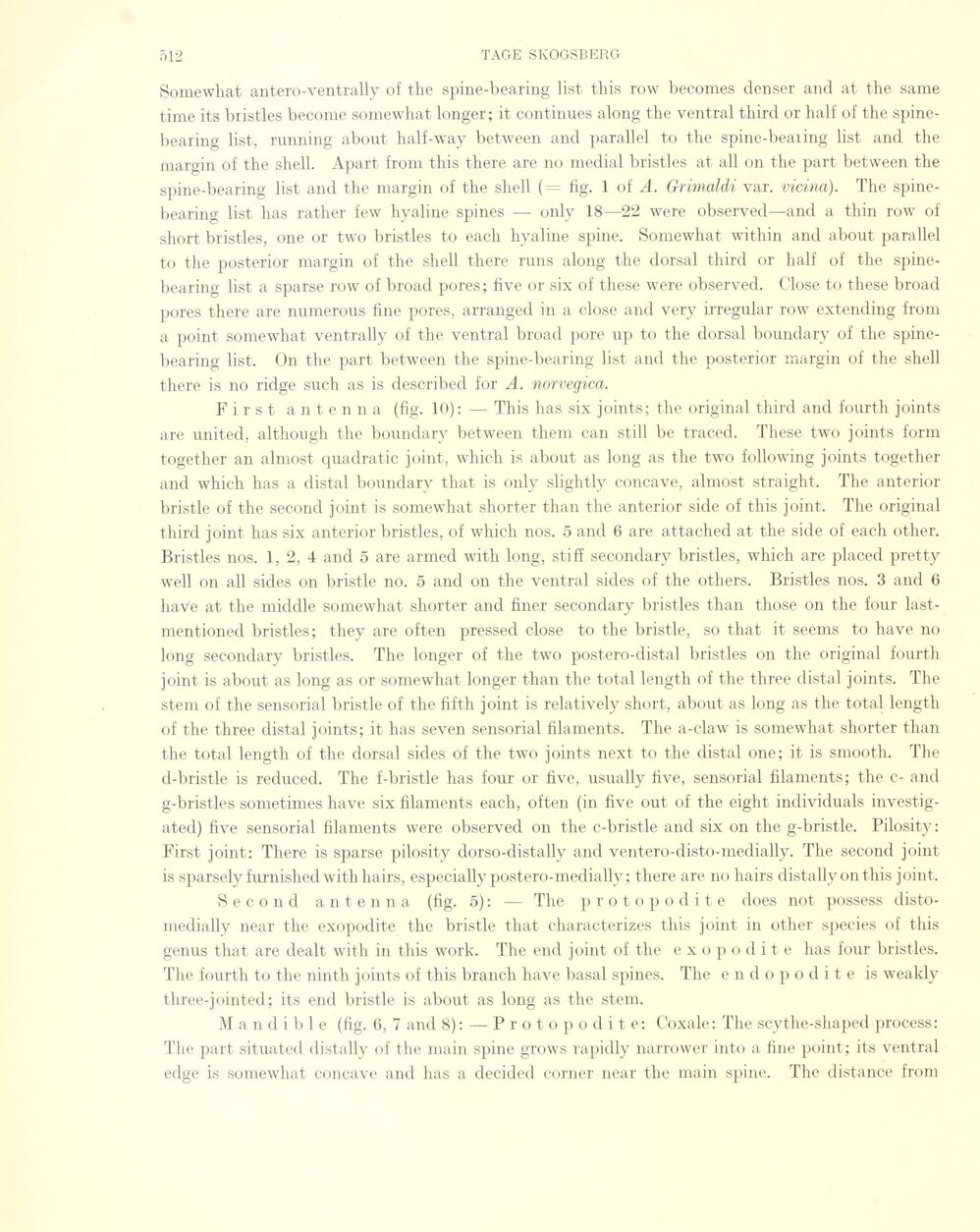
Full resolution (JPEG) - On this page / på denna sida - Sidor ...

<< prev. page << föreg. sida << >> nästa sida >> next page >>
Below is the raw OCR text
from the above scanned image.
Do you see an error? Proofread the page now!
Här nedan syns maskintolkade texten från faksimilbilden ovan.
Ser du något fel? Korrekturläs sidan nu!
This page has never been proofread. / Denna sida har aldrig korrekturlästs.
Somewhat antero-vent rally of the spine-bearing list this row becomes denser and at the same
time its bristles become somewhat longer; it continues along the ventral third or half of the
spine-bearing list, running about half-way between and parallel to the spine-bearing list and the
margin of the shell. Apart from this there are no medial bristles at all on the part between the
spine-bearing list and the margin of the shell (= fig. 1 of A. Grirnaldi var. vicina). The
spine-bearing list has rather few hyaline spines — only 18—22 were observed—and a thin row of
short bristles, one or twTo bristles to each hyaline spine. Somewhat within and about parallel
to the posterior margin of the shell there runs along the dorsal third or half of the
spine-bearing list a sparse row of broad pores; five or six of these were observed. Close to these broad
pores there are numerous fine pores, arranged in a close and very irregulär row extending from
a point somewhat ventrally of the ventral broad pore up to the dorsal boundary of the
spine-bearing list. On the part between the spine-bearing list and the posterior margin of the shell
there is no ridge such as is described for A. norvegica.
First antenna (fig. 10): — This has six joints; the original third and fourth joints
are united, althoiigh the boundary between them can still be traced. These two joints form
together an almost quadratic joint, which is about as long as the two following joints together
and which has a distal boundary that is only slightly concave, almost straight. The anterior
bristle of the second joint is somewhat shorter than the anterior side of this joint. The original
third joint has six anterior bristles, of which nos. 5 and 6 are attached at the side of each other.
Bristles nos. 1, 2, 4 and 5 are armed with long, stiff secondary bristles, which are placed pretty
well on all sides on bristle no. 5 and on the ventral sides of the others. Bristles nos. 3 and 6
have at the middle somewhat shorter and finer secondary bristles than those on the four
last-mentioned bristles; they are often pressed close to the bristle, so that it seems to have no
long secondary bristles. The longer of the two postero-distal bristles on the original fourth
joint is about as long as or somewhat longer than the total length of the three distal joints. The
stem of the sensorial bristle of the fifth joint is relatively short, about as long as the total length
of the three distal joints; it has seven sensorial filaments. The a-claw is somewhat shorter than
the total length of the dorsal sides of the two joints next to the distal one; it is smooth. The
d-bristle is reduced. The f-bristle has four or five, usually five, sensorial filaments; the c- and
g-bristles sometimes have six filaments each, often (in five out of the eight individuals
investig-ated) five sensorial filaments were observed on the c-bristle and six on the g-bristle. Pilosity:
First joint: There is sparse pilosity dorso-distally and ventero-disto-medially. The second joint
is sparsely furnished with hairs, especiallv postero-medially ; there are no hairs distally on this joint.
Second antenna (fig. 5): — The protopodite does not possess
disto-medially near the exopodite the bristle that characterizes this joint in other species of this
genus that are dealt with in this work. The end joint of the exopodite has four bristles.
The fourth to the ninth joints of this branch have basal spines. The endopodite is weakly
three-jointed; its end bristle is about as long as the stem.
M a n d i b 1 e (fig. 6, 7 and 8):—Protopodite: Coxale: The scythe-shaped process:
The part situated distally of the main spine grows rapidly narro wer into a fine point; its ventral
edge is somewhat concave and has a decided corner near the main spine. The distance from
<< prev. page << föreg. sida << >> nästa sida >> next page >>